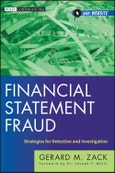Financial statement fraud is one of the most costly types of fraud and can have a direct financial impact on businesses and individuals, as well as harm investor confidence in the markets. While publications exist on financial statement fraud and roles and responsibilities within companies, there is a need for a practical guide on the different schemes that are used and detection guidance for these schemes. Financial Statement Fraud: Strategies for Detection and Investigation fills that need.
- Describes every major and emerging type of financial statement fraud, using real-life cases to illustrate the schemes
- Explains the underlying accounting principles, citing both U.S. GAAP and IFRS that are violated when fraud is perpetrated
- Provides numerous ratios, red flags, and other techniques useful in detecting financial statement fraud schemes
- Accompanying website provides full-text copies of documents filed in connection with the cases that are cited as examples in the book, allowing the reader to explore details of each case further
Straightforward and insightful, Financial Statement Fraud provides comprehensive coverage on the different ways financial statement fraud is perpetrated, including those that capitalize on the most recent accounting standards developments, such as fair value issues.
Table of Contents
Foreword xiii
Preface xvii
Acknowledgments xxi
PART I REVENUE-BASED SCHEMES 1
Chapter 1 Introduction to Revenue-Based Financial Reporting Fraud Schemes 3
Revenue Recognition Principles 3
Changes Proposed by FASB and IASB 5
Overview of Revenue-Based Schemes 6
Chapter 2 Timing Schemes 9
Alteration of Records 9
Shipping Schemes 10
Percentage of Completion Schemes 12
Improper Estimates of Revenue Recognition Period 15
Multiple-Element Revenue Recognition Schemes 17
Customer Loyalty Programs 22
Channel Stuffing 24
Bill and Hold Schemes 27
Sales with Right of Return 29
Improper Pushing of Current Revenue to Future Periods 30
Use of Reserves as a Rainy Day Fund 32
Chapter 3 Fictitious and Inflated Revenue 33
Fictitious Revenue Schemes 33
Sales to Related Parties 37
Infl ated Revenue Schemes 41
Consignment or Financing Arrangements 43
Chapter 4 Misclassification Schemes 47
Recording Financing Arrangements as Revenue 47
One-Time Credits Reported as Revenue 49
Sales Incentive Schemes 50
Chapter 5 Gross-Up Schemes 57
Agent versus Principal 58
Barter and Round-Trip Transactions 59
Phony Revenue and Expenses 61
PART II ASSET-BASED SCHEMES 63
Chapter 6 Improper Capitalization of Costs 65
Start-Up Costs 66
Research and Development Costs 67
Property and Equipment 68
Software Development and Acquisition Costs 71
Website Costs 73
Intangible Assets 75
Advertising Costs 77
Other Deferrals and Prepaid Expenses 79
Inventory Capitalization Schemes 80
Inventory Flow Assumptions 81
Chapter 7 Asset Valuation Schemes 85
Fictitious Assets 85
Inventory Valuation Schemes 86
Inflating the Basis of Property and Equipment 88
Inflating the Basis of Assets Acquired in Noncash Transactions 89
Assets Acquired from Related Parties 92
Understating Depreciation and Amortization Expense 93
Investment Property 95
Improper Valuation of Investments - Financial Assets 96
Loans 104
Equity Method Investments 108
Proportionate Consolidation 109
Improper Classification or Amortization of Intangible Assets 111
Impairment Losses - Nonfinancial Assets 112
Investments in Insurance Contracts 115
Chapter 8 Fair Value Accounting 117
Fair Value Considerations 117
Methods of Measuring Fair Value 118
Internal versus Externally Developed Valuations 124
Inputs Used in Measuring Fair Value 127
PART III EXPENSE AND LIABILITY SCHEMES 129
Chapter 9 Shifting Expenses to Future Periods 131
Timing Schemes Involving Liabilities 131
Accounts Payable 131
Compensated Absences 132
Contingent Liabilities 133
Accrued Compensation 137
Improper Use of Liability “Reserves” 138
Chapter 10 Omissions and Underreporting of Liabilities 141
Debt 141
Guarantees 146
Pension Liabilities 149
Conditional Asset Retirement Obligations 152
PART IV OTHER FINANCIAL REPORTING SCHEMES 155
Chapter 11 Consolidations and Business Combinations 157
Fraudulent Reporting Involving Consolidations 157
Business Combinations 164
Chapter 12 Financial Reporting Fraud as a Concealment Tool 171
Financial Statement Fraud to Conceal Asset Misappropriations 171
Financial Statement Fraud to Conceal Illegal Acts 174
Chapter 13 Financial Statement Fraud by Not-for-Profit Organizations 177
Inflating the Value of Non-Cash Contributions 179
Improperly Reporting Contributions Raised for Others 179
Netting the Results of Fund-Raising Events 180
Improper Allocation of Costs Associated with Joint Activities 182
Misclassification of Expenses 185
Chapter 14 Disclosure Fraud 187
Categories of Disclosure Fraud 189
Common Disclosure Risks 189
PART V DETECTION AND INVESTIGATION 197
Chapter 15 Detecting Financial Statement Fraud 199
Motives for Financial Statement Fraud 200
Fraud Risk Indicators 202
Internal Control Indicators 202
Chapter 16 Financial Statement Analysis 209
Use of Analytical Techniques to Detect Fraud 209
Horizontal Analysis 210
Vertical Analysis 211
Budget Variance Analysis 212
Chapter 17 Ratio Analysis 215
Research on Ratio Analysis 216
Use of Operating Ratio Analysis to Detect Financial Statement Fraud 217
Another Useful Measure: Working Capital to Total Assets 225
Chapter 18 Other Detection Procedures 227
Analysis Utilizing Multiple Ratios 227
Ratios Involving Nonfinancial Data 231
Other Information and Disclosures in Financial Statements 232
Understandability of Financial Statement Disclosures 234
Testing of Journal Entries 235
Chapter 19 Fraud or Honest Mistake? 239
The “Smoking Gun” 240
Witnesses 240
Altered Documents 241
Multiple Records 242
Destruction of Evidence 242
Actions That Contradict Recommendations 243
Patterns of Behavior 244
Personal Gain 244
There’s No Other Explanation for It 244
Chapter 20 Assessing (or Minimizing) Auditor Liability 245
Litigation against Auditors 246
Concealment from the Auditors 247
Auditing Standards 248
Consideration of the Risks of Material Misstatement 249
Improper or Inadequate Use of Analytical Procedures 254
Auditing Accounting Estimates and Fair Values 257
Revenue Recognition Risks 263
Insufficient Consideration of Related Party Transactions 266
Auditing Disclosures in the Financial Statements 266
Overreliance on the Management Representation Letter 267
Appendix: Financial Statement Fraud Indicators 269
Bibliography 275
About the Author 277
About the Website 279
Index 281
Index to Cases 287








